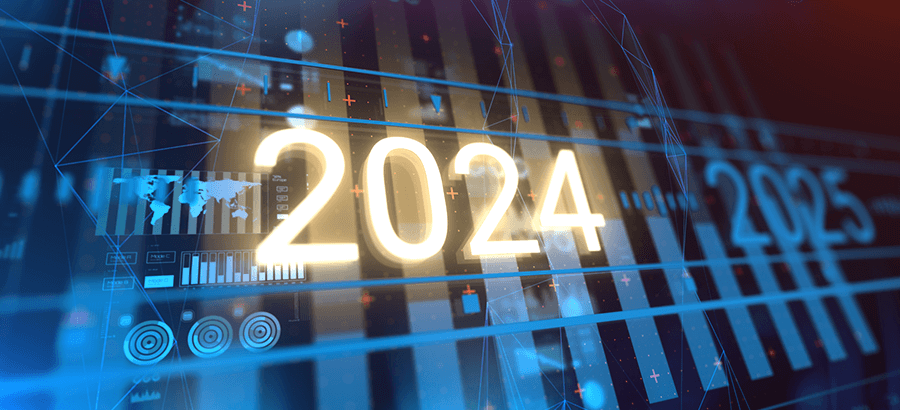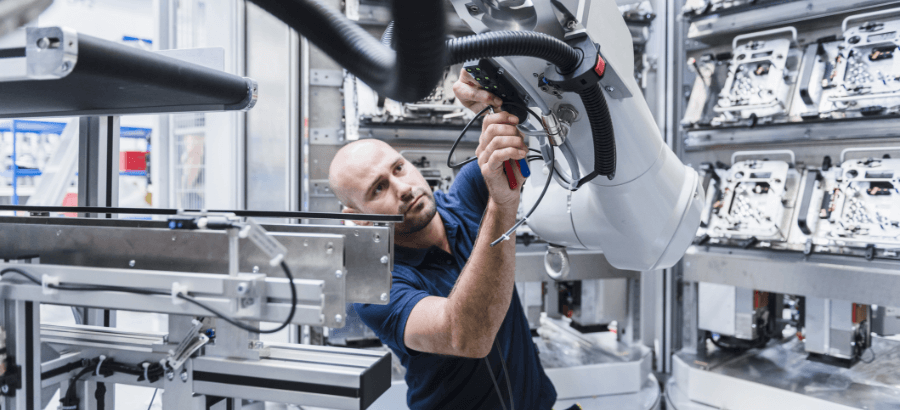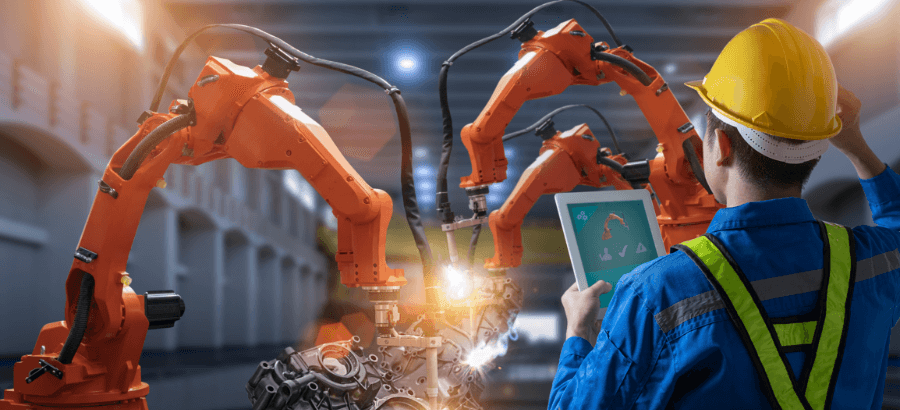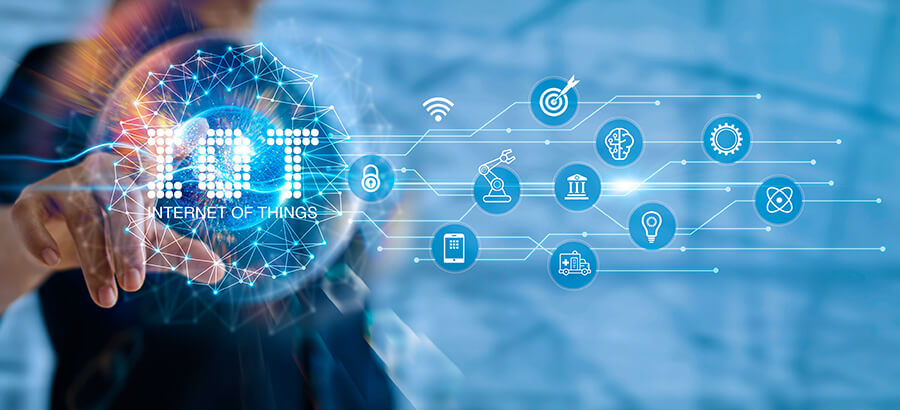ERP trends 2024 – achieving business success through the use of innovative technologies
Now that Artificial Intelligence and Machine Learning are firmly established, we expect to see a massive take-up of these technologies by manufacturers in 2024. Ever-evolving business requirements are another strong influencer as manufacturers strive to improve business processes and efficiencies. Together, these factors will change the way manufacturers view the potential of ERP software.
It’s a sizable market, with research conducted by HG Insights stating that 1.4 million companies are expected to spend $183 billion on ERP software over the next 12 months. This makes up 17.9% of total IT software spend, and 5% of overall IT spending. This market growth is being propelled by the drive to improve operational efficiencies, the competitive advantages to be gained by adopting cloud-based ERP and the benefits offered by AI and ML.
Why manufacturers should consider AI
Generative AI (GenAI) and Machine Learning tools are being added to ERP solutions at a rapid pace, bringing new levels of automation and efficiency to business processes across the manufacturing enterprise. We are starting to see document recognition services in AI which automate tasks such as invoicing, purchase orders and bank reconciliations.
The other emerging area around AI in ERP focuses on trend analysis and forecasting. Although machine learning models have been in place for some time, they are now becoming much more prevalent because of the high volumes of data in ERP systems. This will lead to agile forecasting that creates a more accurate future view.
The ability to improve predictions, automate decisions and streamline workflows that span multiple applications, employees and partners will positively impact the end-to-end manufacturing supply chain. AI also enhances manufacturers’ ability to collect, aggregate and analyze sensor data in real time for production analytics.
Generative AI models will streamline the onboarding of ERP users as well as enhance sales and training processes. Instead of reading through help files, users can type in a question and receive an answer based on real-time data in the ERP system.
Currently, manufacturers are adding AI into existing ways of using applications, which makes it easier to use and configure ERP systems. However, the real power of this will come when entire workflows are created using GenAI, transforming how work is done rather than just making a task easier.
Here are some real-world examples of AI use cases in manufacturing:
- Improve data processing and analytics by recognizing context and generating valuable predictions and insights to help manufacturers make better decisions and optimize their performance.
- Enhance the customer experience by providing a deeper understanding of customer needs and preferences, offering personalized recommendations and support, and ultimately increasing customer satisfaction and loyalty.
- Automate and improve various business processes – such as purchasing decisions, resource planning, human capital management, marketing, and customer service, using smart algorithms, chatbots, digital assistants, voice recognition and other features.
- Enable innovation and transformation by creating new opportunities, products and services and by helping manufacturers adapt to changing market conditions and customer expectations.
Cloud-based ERP momentum continues
Driven by the need to modernize business processes and access cutting-edge technologies such as AI, manufacturers will continue to adopt cloud ERP in 2024. Network infrastructure is a commodity that can be accessed at a lower cost and legacy skill sets are becoming obsolete, making the cloud increasingly attractive. Another factor is the development cycle, with many vendors prioritizing the cloud versions of their products for new functionality.
Cloud ERP solutions give manufacturers many advantages, including lower upfront costs, greater flexibility, effortless scalability and faster implementation. Also, cloud-based ERP systems typically offer automatic updates and maintenance, making it easier for manufacturers with small IT departments (or no in-house IT capability) to ensure they always use the latest version of the software.
While the benefits of migrating to the cloud are significant, the process of migrating an ERP to the cloud is not without challenges for manufacturers. These range from data migration to integration, security and training. However, by planning and testing data migration, using integration tools, choosing a secure cloud provider and training employees, manufacturers can overcome these challenges and take advantage of a cloud-based ERP system.
Using your ERP system as a platform to connect
One of the most important ERP trends for 2024 is a growing tendency for manufacturers to use their ERP systems as a platform to connect every aspect of the business. Technologies like AI and cloud, among others, enhance supply chain visibility. This helps manufacturers to integrate their supply chain and logistics networks, gaining real-time visibility into the entire organization.
By connecting their ERP systems with other systems, manufacturers can eliminate data silos, reduce manual errors, avoid duplication and automate workflows. They can also leverage data from different sources to generate reports, dashboards and alerts that can improve decision-making and optimize operations.
Choosing a modular ERP solution facilitates the ability to integrate and connect with solutions across the business. Implementing a selection of modular micro-services that function together to provide a comprehensive ERP platform enables manufacturers to exploit the capabilities they need without investing in functionality that doesn’t contribute to their strategies.
In addition, connecting ERP with other platforms like CRM or e-commerce tools bridges the gaps in business processes. It’s like a neural network where every part communicates efficiently. Instead of isolated pockets of data, there is a seamless flow of information. This interconnectedness reduces errors from manual data entries, saves time with automated processes, and provides a comprehensive view of business health.
Integrating ERP with other systems also gets information to a larger community of users who can rely on its accuracy and quicker access to get the data they need to make relevant, real-time decisions.
ERP trends 2024 – Prioritizing internal sustainability
Over the past few years, black swan events such as the pandemic, geopolitical tensions and escalating interest rates have proven that manufacturers can survive these unexpected crises. To counter external threats and macroeconomic events beyond their control, manufacturers are building internal resilience through cost efficiencies and increased margins – a trend that is set to continue.
There are signs that manufacturers are focusing on these efforts as a priority over environmental sustainability, which is seen as a luxury compared to the need to survive and prosper. More important is identifying ways to streamline internal processes so that the business is sustainable.
The trend analysis and forecasting capabilities of AI play a role here, feeding into the need to streamline processes from a sustainability perspective. For example, by creating a model and specifying the impact of rising inflation and/or oil prices, manufacturers can manipulate their forecasts based on the resulting data.
This approach is ushering in a new era of responsible growth, with companies understandably reluctant to deviate from the pursuit of profits, yet only willing to aim for conventional business targets when this can be achieved in conjunction with enhanced risk management. By gaining visibility into their data, manufacturers can enhance their resilience and take advantage of new opportunities such as expanding into new markets or innovating a new product line.
This leads into a new concept: antifragility. In a volatile world with a high level of destructive uncertainty, the wise economic strategy is to be antifragile: protect the downside but prepare to benefit disproportionately from potential external negative events and in all cases avoid fragility. Examples of antifragile companies include Amazon, Netflix, Tesla and Alibaba. These companies have demonstrated resilience, adaptability and the ability to capitalize on changing market conditions.
Conclusion
For manufacturers, the trends outlined above will be high on the decision-making agenda and are set to influence forward-thinking strategies. However, some of what will dominate ERP business discussions in 2024 will be familiar, including issues around costs and spending, data, personnel, business processes and risk management. These issues permeate every manufacturer of every size and will continue to influence ERP trends this year.








1 thought on “Capitalizing on ERP trends in 2024”
New developments in artificial intelligence will be the main force for the development and simplification of technological processes. Already, technical innovations in artificial intelligence, AR, IoT, quantum computing, GreenTech and Deep Tech are simplifying the development of digital business models and helping to optimise workflows. This is the near future of most industries, including logistics. Today, the latest ideas of artificial intelligence make it possible to accurately calculate the cost of delivery, create a wide range of different opportunities that simplify the planning of logistics processes, allow you to control the level of traffic safety and take into account possible risks. The introduction of high technology can be seen in the simplification of customs declarations: zollinhaltserklärung CN22 https://dashboard.shipstage.com/faq/article/122-zollabwicklung-ausserhalb-der-eu/ Together, such technical innovations and digital business models provide an excellent foundation for development in 2024.